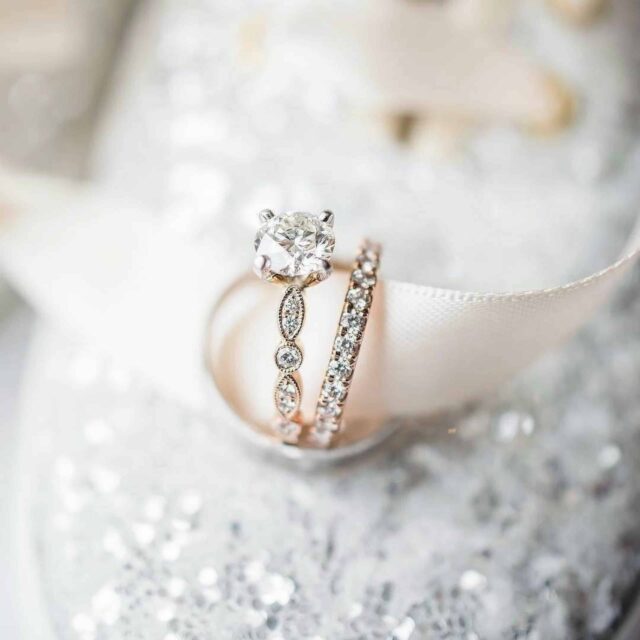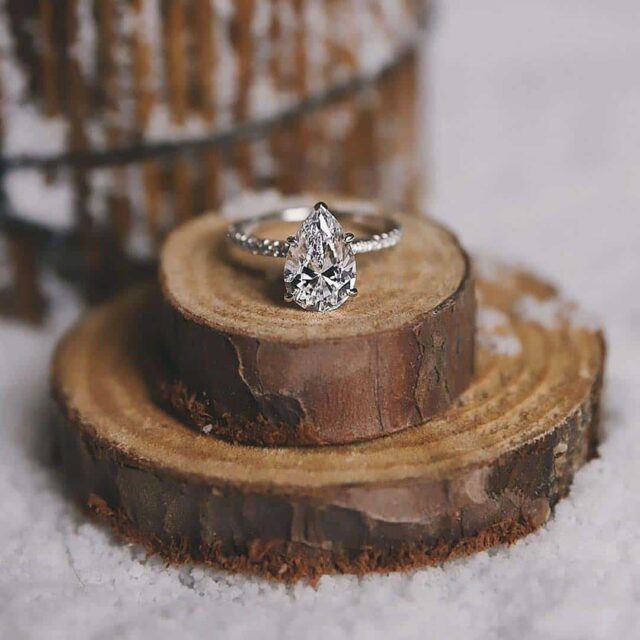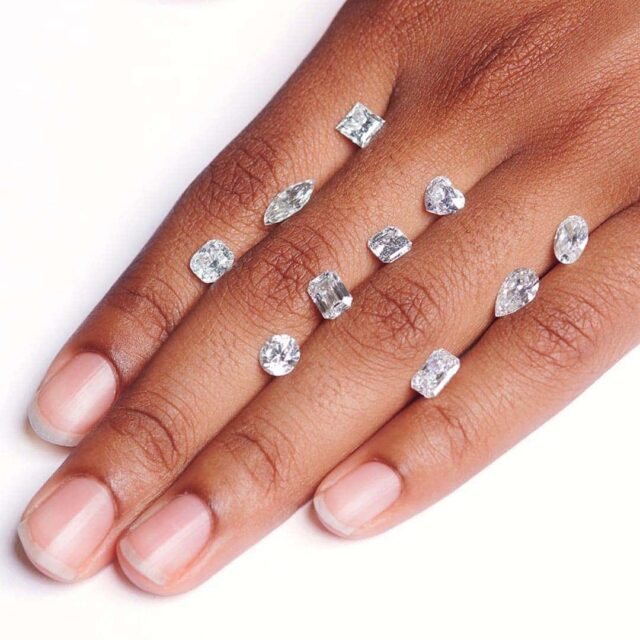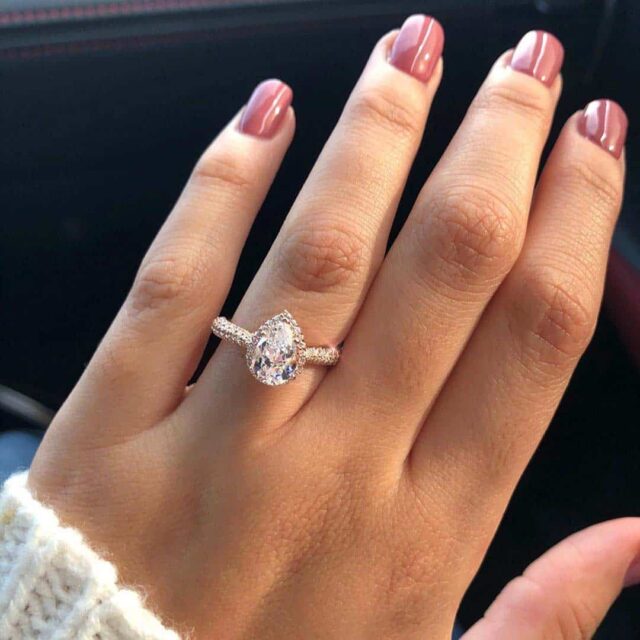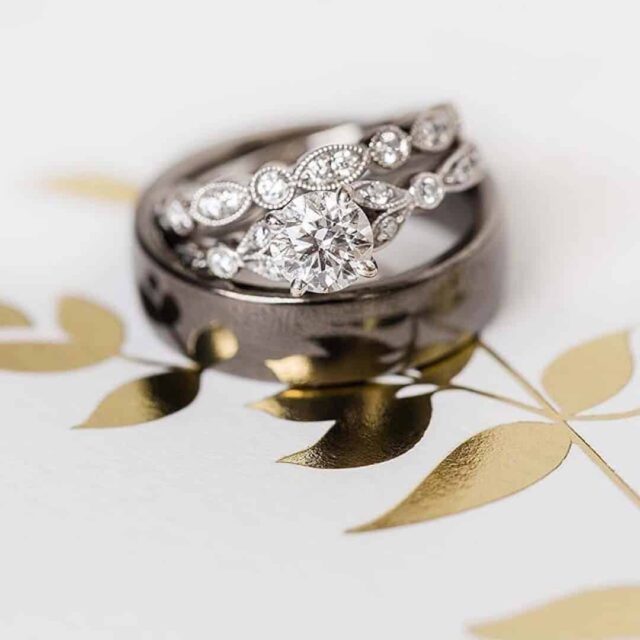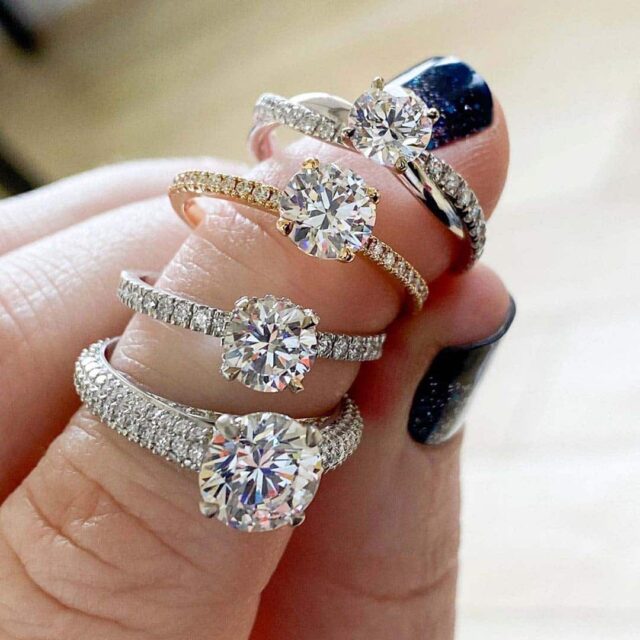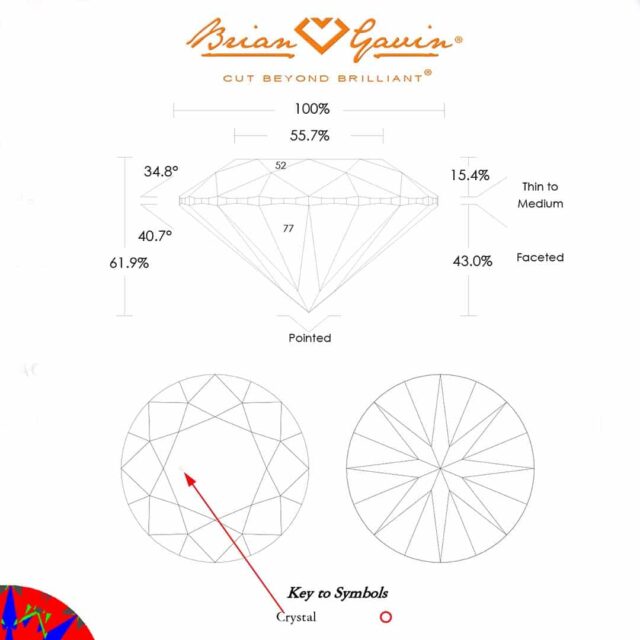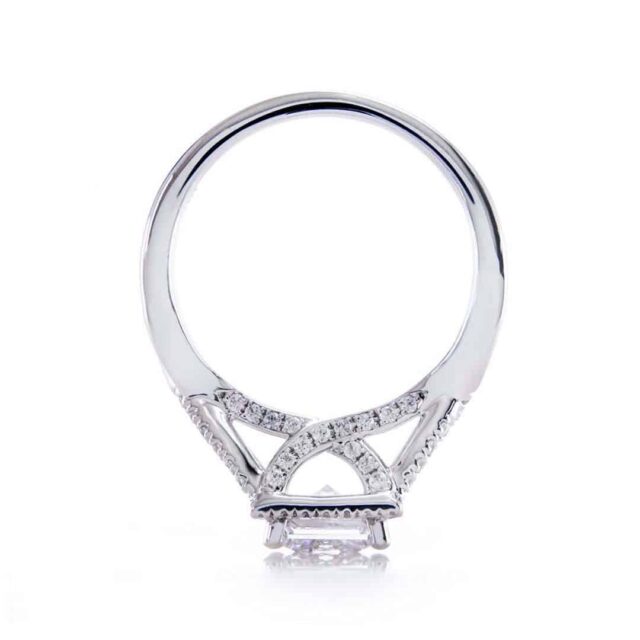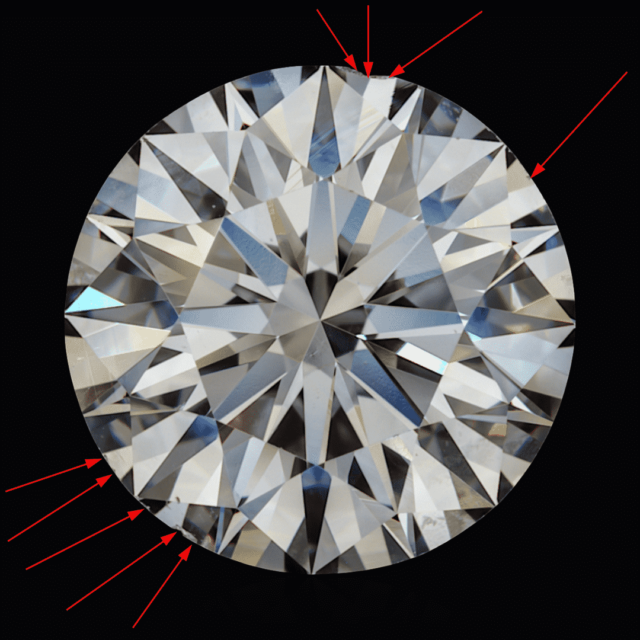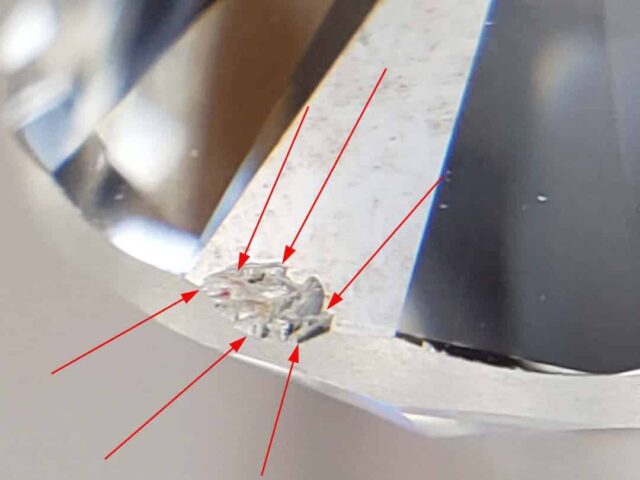Chipped diamonds are not the kind of thing that people like to think about when buying an engagement ring. So, you might be wondering why we have a page about chipped diamonds.
In the first place, it's because people often refer to accent stones as diamond chips. For example, the little round diamonds in this milgrain marquise and dot setting from Blue Nile are small enough to be considered chips.
However, the correct term for diamonds weighing less than 0.20 carats is melee [mey-lee, me•lee]. Secondly, you might have accidentally chipped your diamond and are exploring your options.
What To Do If You Chip Your Diamond:
If the center stone in your engagement ring chips, the best option is to file a claim with your insurance company. We are assuming, of course, that you have insurance coverage that covers accidental damage.
Consequently, we can assist you with locating a suitable replacement for chipped diamonds. If you do not have insurance for the diamond, then you might consider having it recut.
However, recutting a diamond does involve risk because the chip can extend and fracture the diamond. Under those circumstances, it's better to let the insurance company take the risk if that is an option.
Chipped Diamonds Create Disbelief & Confusion:

Chipped Diamonds Experiments Gone Wrong.
Whenever somebody chips a diamond, the variety of reactions usually includes disbelief and confusion. After all, everybody knows that diamond is the hardest mineral substance on earth.
Therefore how can there possibly be chipped diamonds?
Well, the keyword to focus upon here is mineral.
Diamond is not the hardest substance on earth; it is the hardest mineral.
That means you can scratch the surface of a diamond with the pop-top from a can of soda.
Right about now, your mind is probably swimming with the possibilities of chipped diamonds. So we might as well finish it off.
How to Bruise, Chip, or Scratch a Diamond:
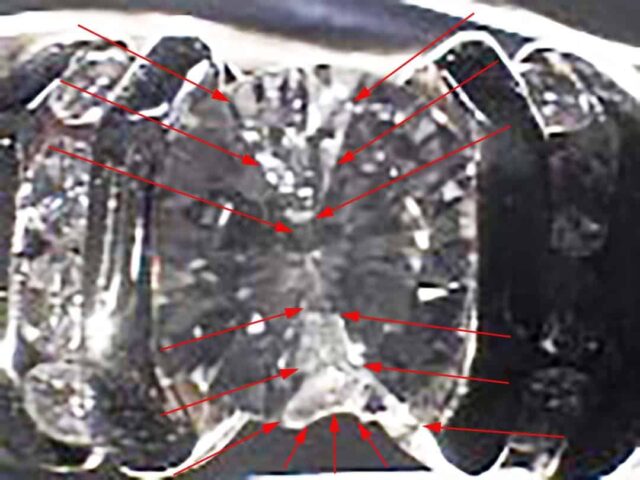
Example of Chipped Diamonds 10x Magnification.
Believe it or not, this is a photograph of a chipped diamond as seen under 10x magnification. Although the diamond is rectangular in shape, it looks more square because a good portion of the diamond broke away.
This chip is pretty substantial. It extends from the upper table facet, down through the girdle, and deep into the pavilion.
Consequently, the damage results from striking the ring against the kitchen counter during an aerobics session.
Under normal circumstances, the odds of chipping your diamond during normal wear are quite slim. However, it is a possibility that you should be aware of so that you can take proper precautions. Clearly, it's not a good idea to wear your ring while doing strenuous physical exercise.
Reduce the Chance of Chipped Diamonds:
To Reduce the Chance of Chipped Diamonds, Remove Your Ring Off While:
There are many more activities where it's probably best to take your ring off for safekeeping. For example, you should hire a housekeeper to avoid damaging your diamond while housekeeping. We accept no liability with regards to that statement.
But seriously, use common sense when wearing your ring. We know that you want to wear your e-ring 24/7. However, the reality is that jewelry is decorative by design and too delicate to be worn during strenuous activity.
"My Jeweler Chipped My Diamond”
"I had my mother’s diamond reset by a local jeweler and they chipped the culet! You can imagine how upset I was. The diamond was beautiful. Every jeweler who has seen it raved about how beautiful it sparkled. I’ve filed an insurance claim, but no amount of money can replace the sentimental value."
That is an excerpt of an email from one of our clients. Consequently, the polishing and setting processes are the most dangerous times in a diamond's life. The amount of pressure applied to rough diamond crystals during the cutting process is incredible.

Chipped Diamonds Marquise at 10x Magnification.
Jewelers apply vast amounts of pressure to the girdle edge of a diamond while setting them. The jeweler clamps down upon the prongs with a particular set of pliers, crimping them down along the girdle edge.
There is the risk of chipping or damaging the girdle edge or culet of the diamond. It's a sad truth, but diamond setters probably break, chip, and damage more stones than their customers do.
For instance, the tip of this marquise diamond broke off while a jeweler was tightening the prongs. Imagine stopping by your local jeweler for a routine inspection and cleaning, and they destroy your diamond in the process!
The Tip Snapped Right Off!
Notice how the entire right tip of this marquise cut diamond is missing. The damage extends almost to the edge of the table facet of the diamond.
Do you see how a diamond cutter might turn the diamond above into a pear shape? Recutting this chipped marquise cut diamond into a pear shape is the best way to reduce the loss.
Sometimes, these types of accidents result from an inherent problem within the diamond's internal structure. Clarity characteristics such as extensive feathers, cavities, and knots are potential risks for jewelers.
A very thin girdle edge or internal crack near the diamond surface can be a recipe for disaster. However, damaging a diamond is also sometimes the result of inexperience or carelessness on the jeweler's part.
How That Marquise Diamond Chipped:
It's a tragic story. The owner of the ring had taken it to her jeweler for a routine cleaning and quarterly inspection.
While inspecting the ring, the sales clerk noticed that the center stone was loose. As a result, the ring was left with the store so that the jeweler could tighten the diamond.
Unfortunately, the ring owner's eyesight is not-so-good. Therefore she didn't notice the damage to her diamond before leaving the store. Not surprisingly, the sales clerk didn't offer to show her the ring under magnification at the time of pick-up.
If your diamond sustains damage, you might want to pick a different shape. This photograph shows the most popular diamond shapes from Blue Nile.
Time Waits For No Man (or Woman):
The owner of this ring did not discover the chip in her diamond until three months later. That's when she took her engagement ring back into the store for the next contractual quarterly inspection.
Naturally, the sales clerk showed her the chipped diamond under magnification at that time. But by then, the jewelry store was under new ownership.
The in-store insurance policy denied her claim because she could not prove that the jeweler was at fault. After all, it's also possible that the damage was the result of abuse or neglect.
The new owner of the store suggested that the customer file an insurance claim for the chipped diamond. They sent her to us for verification, valuation, and replacement.
Solving the Mystery of Chipped Diamonds:
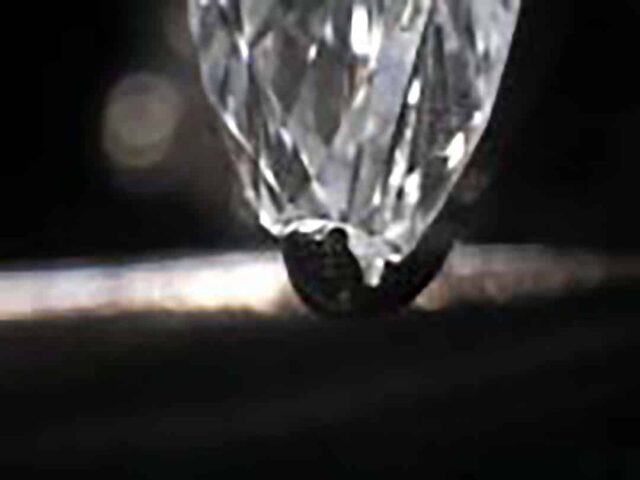
Chipped Diamonds Marquise Tip 10X Magnification.
Upon inspection of the insured's diamond, we determined that the diamond was secure in the seat. The diamond was not loose or rocking in the head that holds it in the setting. The prong is set firmly against the stone's surface.
The chip wraps up and extends around the surface of the prongs. Based on these facts, it is our opinion that the jeweler over-tightened the prong.
In essence, the jeweler drove the prong into the diamond, causing it to fracture, as seen here. Fortunately for the insured, her homeowner's insurance company authorized us to replace her diamond.
Unfortunately, the replacement cost of the chipped diamond exceeded her policy limits. Our client ended up paying the $2,000.00 difference out of her pocket.
However, the reality is that she was lucky because her insurance company could just have easily denied the claim. After all, she did not specifically insure the ring under her homeowner's policy.
Lessons We Can Learn About Chipped Diamonds:
Jewelry Insurance Should Cover:
Most homeowners insurance policies provide a minimal amount of jewelry coverage. It is rarely adequate for replacement purposes. In that case, we recommend that you purchase additional jewelry coverage that will provide for a full replacement.
What About In-store Jewelry Insurance Policies?
In our experience, most in-store insurance policies are not worth the price of the paper and ink.
In-store jewelry insurance policies seldom seem to pay for loss or damage. Also, don't make the mistake of thinking that those in-store jewelry insurance policies are free.
The reality is that you pay a hefty premium for them, especially if they fail to protect you. In-store jewelry insurance policies seem to be a great marketing tool but are of little legitimate value for the customer.
Under those circumstances, you are better off insuring your engagement ring on your homeowner's policy. You can also purchase a standalone policy from Brite.co, or Jewelers Mutual.
How To Protect Yourself From a Disreputable Jeweler:
Always inspect your jewelry items when leaving them for repair and when picking them back up! Insist on inspecting your jewelry in the presence of store personnel. Take nothing for granted.
Be aware that most jewelry stores prefer to be vague about what you're dropping off for repair for liability reasons. That is a standard industry practice that most insurance companies support to reduce the liability of the stores they insure.
Most jewelers will not describe your 1.137 carat, VS-1 clarity, K-color, Brian Gavin Signature diamond in full detail. Instead, they're more likely to write:
"Ladies gold-colored metal ring with round white stone."
Such vague descriptions serve to protect the jewelry store from fraudulent accusations of stone-switching.
Protecting You and Your Jeweler Against Chipped Diamonds:
In light of such vague take-in practices, you can adequately protect your jewelry with a few simple steps. The first of which is learning to identify your diamond and verify its characteristics and condition.
We carefully inspect every piece of jewelry that we take in for repair. Involving our customers by teaching them what to look for creates peace of mind for all of us.
How to Plot Inclusions:
The process is quite simple, draw a picture of the piece of jewelry on the repair envelope. Include a separate drawing, plot, or map of your diamond indicating the clarity characteristics.
Be sure to note all of the inclusions and blemishes, such as scratches, naturals, and chips. Ask the gemologist at the jewelry store to help you get it right.
Here is the plotting diagram from the AGS Diamond Quality Document for this 1.137 carat, K-color, VS-1 clarity, BGD Signature diamond. The primary inclusion is the diamond crystal located at the tip of the red arrow.
All you have to do is draw a simple diagram like this when dropping your ring off at a jewelry store. Sketch a circle, make a little circle representing the diamond crystal, and point an arrow at it.
Your drawing doesn't have to be a work of art. It just has to provide a reasonable visual description of your diamond.
Crossing the T’s & Dotting the i’s:
Protecting Yourself From Chipped Diamonds.
The next step is to record the approximate dimensions of your center stone by using a micrometer. It's probably best to ask the store clerk to assist you with measuring your diamond.
The Brian Gavin Signature diamond referenced above measures 6.68 – 6.70 x 4.14 millimeters. In this case, there is an inscription on the girdle edge that features the BGD logo along with the diamond grading report number: 104082148022, so we'll also record that on the job envelope.
The last step is to initial your drawing and ask the store clerk to verify the details. They're also going to want to verify the condition and characteristics of your diamond.
Be sure to have them place their initials next to your sketch of the inclusions within your diamond. Considering that you can write a legally binding contract on a napkin, this a bit of an upgrade.
Reasonable Protection From Chipped Diamonds:
Most jewelry stores will not specify the carat weight, color, or clarity of diamond on take-in for service. That is because it can be difficult to ascertain these details when the diamond is in a setting.
However, it would not be smart for somebody to switch your diamond if you've taken the previous steps to document it properly.
Nobody in their right mind will try to switch out a stone when the repair envelope features a plotting diagram.
Likewise, it would be difficult to dispute the presence of a chip not previously noted on the repair envelope.
Note: A reputable jewelry store should not be offended by your effort to protect your investment. The process is no different from inspecting the condition of a rental car before taking delivery of it.
You're also going to walk through an apartment before you rent it. You're also going to pay for an inspection and do a walk through before you buy a house.
The sad truth is that there are dishonest jewelers out there. Accidents do happen, and you, therefore, have the right to take reasonable precautions to protect yourself.
What To Do About Chipped Diamonds:
In other words, what to do if you suspect that your jeweler chipped your diamond. First of all, we are not attorneys. In that case, this is not legal advice. However, this is what we would do if we thought our diamond (or other jewelry items) was damaged while in the care of a jeweler:
Do NOT remove your property from the jewelry store, or you may release the store from liability!
If they refuse to cooperate, or you are not satisfied with their response, politely refuse to take delivery of the jewelry item. Leave the store and call your insurance company to file a claim and let them take care of the rest.
Keep Calm & Shine Bright Like a Diamond:
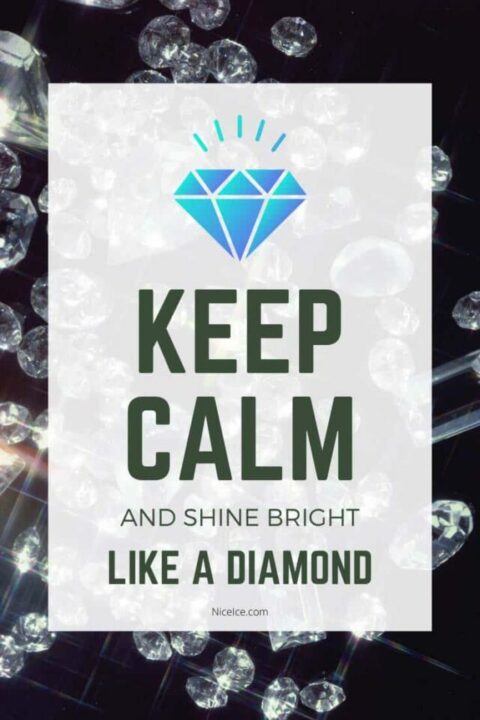
Keep Calm & Shine Like a diamond.
Remain calm and be polite. Flying off the handle isn't going to improve the situation.
Calmly advise them that your insurance company will be in contact with them regarding the chipped diamond.
Let your insurance claims agent settle the dispute for you. It is in their best interest to see that the jewelry store takes responsibility for its mistakes.
Do not threaten legal action, make a scene, or libel them on social media. Doing so might cause you to incur civil liability for any monetary loss that the store incurs due to your actions.
Consequently, they could claim that you damaged their reputation or caused another customer to leave the store (loss of business).
What To Do If Your Diamond Is Chipped:
If your diamond sustains damage, there are several options available to you. Deciding what to do, depends upon the severity of the chip.
Assuming that your diamond ring is appropriately insured, submit a claim and move forward. You might be able to have the diamond recut if the damage is minimal.
However, the proportions of recut diamonds are most often inferior to diamonds cut direct from the rough. You might also incur a substantial loss of carat weight, which means a significant loss of value. It's usually best to just let the insurance company take the loss and move on.
As you can see, this diamond has multiple chips along the girdle edge. In this case, the most severe is in the relative 12 and 7 o'clock positions.
Is It Okay to Wear Chipped Diamonds?
This photograph is a close-up of the chip shown in the 12 o'clock position in the face-up position above. Sometimes chips are minute and do not pose any real danger to the longevity of the diamond.
In that case, you might choose to ignore it and reset the diamond in a setting that offers better protection. However, this chip is substantial in size, and there is potential for it to spread.
Sometimes chips are minute and do not pose any real danger to the longevity of the diamond. In that case, you might choose to ignore it and reset the diamond in a setting that offers better protection.
By the way, it's not always the jeweler who is guilty of chipping a diamond. You can chip a diamond yourself by banging it around or in the course of normal wear and tear.
Consequently, one of our clients chipped her diamond while gardening. Another one of our clients chipped her diamond by banging it against a marble counter while exercising.
Remember to take your ring off when doing active things. The diamond on your finger is just a beautiful mineral crystal cut to sparkle! You've got to take care of it if it's going to last.
Recutting & Salvaging Chipped Diamonds:
The value of a chipped diamond declines dramatically due to the damage. Regardless of the chip's size or location, the value of the diamond takes a severe hit. I'm sure you realize that pun is intentional.
In this case, the diamond's original weight was 1.69 carats and 1.51 carats after being recut by Brian Gavin. Consequently, this diamond is not cut to Brian Gavin Signature standards because it was essential to maintain weight above 1.50 carats.
When an insurance company pays to replace a chipped diamond, the damaged diamond becomes their property. To reduce their losses, many insurance companies sell the "salvage" for pennies on the dollar.
In that case, they may sell the salvage to diamond cutting companies that specialize in recutting chipped diamonds. It is not uncommon to find insurance salvage for sale in retail jewelry stores. Salvage stones entering the market as bargains may have chips hidden under a prong or bezel.
Considerations for Recutting Chipped Diamonds:
This ASET Scope image shows the light performance of the diamond after being recut by Brian Gavin. In this case, the diamond's visual properties are better due to the skill of the cutter.
Diamond cutters can re-facet chips to hide the damage. However, the shape of the diamond might be slightly off. Take the marquise cut diamond above; they could recut it into a pear-shape.
However, if they only round off the broken part, the facet structure will not be right. Neither will the length to width ratio because the diamond will seem too long.
When purchasing a diamond, carefully view the diamond under 10x magnification (or higher) from all angles. Pay particular attention to the facets along the girdle edge of the stone.
Consequently, discovering a chip on a diamond does not necessarily mean that it's insurance salvage. However, it is reasonable to assume that the jeweler will pay much less for a chipped diamond. After all, a new car costs more than one from the salvage yard.

